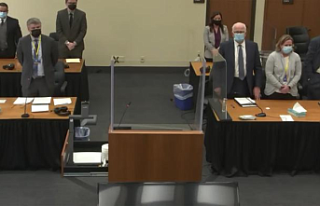Tuesday's question went right to the heart. The former officer claimed that Wright was shot because she pulled out her Taser instead of her gun during a traffic stop in Brooklyn Center, Minneapolis.
Prosecutors highlighted the differences between Potter's gun, Taser, and promised jurors that they could handle them during deliberations.
Although rare, these mix-ups have occurred in several states over the past few years.
The trial of Kim Potter resumes Wednesday for the jurors
These are some questions and answers:
HOW Often does this happen?
Experts agree that such incidents occur very rarely and are unlikely to happen more than once a year in the United States. In a 2012 article in Americans for Effective Law Enforcement, nine cases were documented in which officers used handguns to shoot suspects who claimed they meant to use stun guns.
Youtube video thumbnail
According to Seth Stoughton (a University of South Carolina School of Law professor), the phenomenon of "weapons chaos" is well-known in policing. According to him, he had "fewer than twenty" instances in which officers were using Tasers since 1993 when they were first introduced. He stated that the manufacturer had taken steps to avoid such errors, and that it has become an integral part of the training officers receive.
WHY IS IT COMMON?
Officer training, how they carry their guns and the pressure they feel in chaotic and dangerous situations are all reasons that have been mentioned. Officers tend to carry their stun guns on the weak side of their bodies, rather than holstering their dominant hand. This helps avoid confusion. This is how Potter carried hers.
Potter's trial featured testimony by a state Bureau of Criminal Apprehension agent on the differences between the weapons and how officers use them. There were also photographs to illustrate the point.
Sam McGinnis stated that Potter's duty belt holsters require officers to take deliberate actions in order to remove the weapons. The pistol holster is equipped with a snap while the Taser-holster uses a lever. He said that the black handgun is just over 2 pounds (0.9 kgs) and the predominantly yellow Taser is just under 1 pound (0.45 kgs).
McGinnis also testified that the gun and Taser have different triggers, grips, and safety mechanisms. Both must be engaged before firing. McGinnis demonstrated the Taser's LED and laser lights before it fires, which he showed to the jury. The handgun doesn't.
What DOES THE DEFENSE SAY ABOUT IT?
A defense expert in the use of force testified that even in chaotic situations, such as Wright's traffic stop at Wright, one's ingrained training can take over.
Laurence Miller, a Florida Atlantic University psychologist, stated that repetition makes it easier to think about the act. He explained that when someone learns a new skill their memory might override it, which could lead to an "action error", where an intended action has an unexpected effect.
He said, "You have an intention to do one thing and think you are doing it. But, you do something else, only to realize that what you meant was not what you did."
Paul Engh, defense attorney, stated that "we are in a human enterprise." "Police officers can be human beings." That's exactly what happened."
Bill Lewinski is an expert in police psychology and founder of the Force Science Institute, Mankato, Minnesota. He uses the term "slip-and-capture" to describe the phenomenon.
Lewinski has testified for police and said that officers can sometimes do the opposite of what they intended under stress. That is, their actions slip and are "captured by a stronger reaction." He points out that officers spend far more time drawing and firing their guns than on using stun guns.
Others are skeptical about the theory.
Geoffrey Alpert is a University of South Carolina criminology professor and expert on the use of force by police officers. It's a good theory but we don't know if it's true.
Alpert stated that a major reason officers draw incorrectly their firearms is because stun guns look and feel exactly like firearms.
What are some other cases?
One of the most well-known cases was when a transit officer responding in an altercation at a train station near Oakland, California, shot and killed Oscar Grant, 22 years old. Johannes Mehserle, who testified during trial, said that Grant reached for his stun gun, but mistook it for his.40 caliber handgun.
Mehserle was sentenced to two year imprisonment for involuntary murder. Grant's mother and daughter were each paid $2.8million by his department.
Robert Bates, a white volunteer sheriff's deputy in Oklahoma, claimed that he accidentally fired his gun when he intended to use his stun gun against Eric Harris, an unarmed Black man. Harris was being held down in 2015 by other officers.
Harris was killed by Bates. However, Bates offered his condolences and described the fatal error as a common problem within law enforcement. He said that "This has happened many times across the country." It can happen to anyone, you must believe me.
Bates was sentenced to four-years imprisonment for second-degree manslaughter. Tulsa County eventually agreed to $6 million for Harris' estate in settlement of a federal civil rights suit.
Julia Crews, a suburban St. Louis officer, claimed she intended to use her stun guns but mistook her service revolver for her gun and shot Ashley Hall, a suspected shoplifter. Hall sustained serious injuries. Crews was arrested for second-degree assault and resigned. Hall requested that the charges be dropped and Crews, the victim and former officer, agreed to mediation in the area of restorative justice. Separately, Ladue reached a $2million settlement with Hall.












